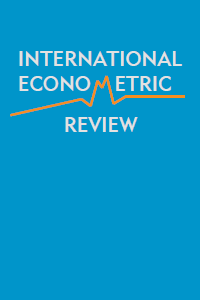Methodological Mistakes and Econometric Consequences
Methodological Mistakes and Econometric Consequences
Econometric Methodology is based on logical positivist principles. Since logical positivism has collapsed, it is necessary to re-think these foundations. We show that positivist methodology has led econometricians to a meaningless search for patterns in the data. An alternative methodology which relates observed patterns to real causal structures is proposed.
Keywords:
Econometric Methodology, logical positivism, realism, causality, VAR models, Forecasting, surprise goodness of fit.,
___
- Atiq-ur-Rahman, (2011). “Impact of Model Specification Decisions on Unit Root Tests,” International Econometric Review, 3(2), 22-33.
- Ayer, A. J. (2008). interview with Brian Magee, www.youtube.com/watch?v=4cnRJGs08hE
- Barzel, Y. (1972). “The rate of technical progress: The “Indianapolis 500” Journal of Economic Theory, 4(1), 72-81.
- Freedman, D.A. (1997). From Association to Causation via Regression.In Causality in Crisis?ed. V. McKim and S. Turner.University of Notre Dame Press, South Bend, (with discussion) 113-82. Reprinted in Advances in Applied Mathematics, 18, 59-110.
- Freedman, D. A (1991). “Statistical Models and Shoe Leather”. Sociological Methodology, 21, 291–313.
- Freedman, D.A. (2008). On types of scientific enquiry: Nine success stories in medical research. In The Oxford Handbook of Political Methodology, ed. Janet M. Box-Steffensmeier, Henry E. Brady and David Collier. Oxford University Press, Oxford.
- Freedman, D.A.; Pisani, R. and R. Purves (2007). Statistics. Norton, New York
- Hendri, S.B. (2012), “Export Led Growth Hypothesis: An Analysis of Indonesia’s Trade Policy Pre and Post 1997 Financial Crises” Ph.D. Thesis submitted to IIIE, International Islamic University of Islamabad.
- Hendry, D.F. (1993). The Roles of Economic Theory and Econometrics in Time-Series Economics. In European Econometric Society, Invited address, Stockholm.
- Hoover, K. D. (2004). “Lost Causes” Journal of the History of Economic Thought, 26(2), 149- 164.
- Hoover, K.D. (2005). “The Methodology of Econometrics”, article in Palgrave Handbooks of Econometrics, volume 1: Theoretical Econometrics.
- Leamer, E. (1978). Specification Searches: Ad Hoc Inference with Non Experimental Data. John Wiley and Sons Inc., New York.
- Leamer, E. (1983). “Lets take the con out of Econometrics”, The American Economic Review 73(1), 31-43.
- Magnus, J.R. (1999). The success of econometrics. De Economist, 147(1), 50-58.
- Manicas, P. (1987). History and Philosophy of the Social Sciences, Oxford: Basil Blackwell
- Manicas, P. (2006). A Realist Philosophy of Social Science: Explanation and Understanding, Cambridge: Cambridge University Press
- Oaksford, M. and Chater, N. (2007). Bayesian Rationality. Oxford: Oxford University Press
- Russell, Bertrand. (1905). "On Denoting", Mind, 14, 479–493.
- Sims, C.A. (1980). “Macroeconomics and Reality,” Econometrica 48, 1-48.
- Frederick, S. (1977). The Structure of Scientific Theories 2nd edn. Chicago: University of Illinois Press
- Thomas, R. L. (1993). Introductory Econometrics: Theory and Applications, 2 nd Edition Longman.
- Van Fraassen, Bastiaan, C. (1980). The Scientific Image , New York: Oxford University Press
- Wong, S. (2006). The Foundations of Samuelson’s Theory of Revealed Preference, Routledge,
- Zaman, A. (1996). Statistical Foundations of Econometric Techniques, Academic Press. Zaman, A. (2008). Post Positivist http://ssrn.com/abstract=1319048 or http://dx.doi.org/10.2139/ssrn.1319048 Probability Available at SSRN:
- Zaman, A. (2010). “Causal Relations via Econometrics”, International Econometrics Review, 2(1):36-56
- Zaman, A. (2011). The Normative Foundations of Scarcity, to appear in Real World Economics Review, 60
- ISSN: 1308-8793
- Başlangıç: 2009
- Yayıncı: Ekonometrik Araştırmalar Derneği
